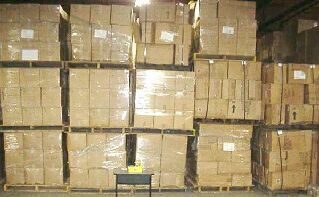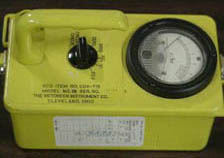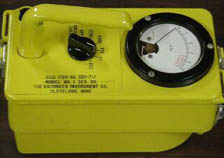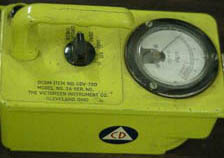
| Bruce Beach Nuclear Survival
Resources | ||
| Main Contents Page Here | Mirror
This Site |
Programming
Provided By: KI Anti-Radiation Pill FAQ |
Other countries provide fallout shelters and radiation equipment for their populations. China, Russia, and some other countries claim that they have a spot for every member of their population. Some like Switzerland and Sweden have two or three spots for every person, in case they would happen to be away from home at work or school. There are a number of countries, like Israel, that have for years required that every new building include a fallout shelter. But in North America there is no requirement to have shelters and I believe the reason is because unlike with missiles and weapons, there is no way large corporations can centrally or mass produce fallout shelters and make a buck. Consequently, there has been no effective lobby for shelters. If they could have been mass produced on an assembly line then it would have been a law that everyone had to have one.
There are always two aspects to warfare. The sword and the shield. Today, nuclear weapons are the sword. Fallout shelters are the shield. The Defense Department is misnamed. It is really the Destruction Department. It only has the sword. For the North American populaton there has been provided no shield (defense).
Instead, the US and Canada have closed the shelters that they had. They have taken down the signs and destroyed the supplies. The radiation detectors have been sent back to central warehouses and auctioned off as government surplus. In this page I am going to try to explain to you about these types of equipment. What you should look for, and what you should avoid.

In the warehouse picture there is a desk in front of the pallets and on the desk there is sitting a single instrument. Perhaps a...
 |
 |
 |
| CDV-715 | CDV-717 | CDV-720 |
But there is a problem. While these meters look nice - most of them, unfortunately, are probably now worthless because the government hasn't take care of them. The problem is sort of like looking for diamonds in a diamond mine. You have to move a lot of overburden to find one that works.
One outfit that is doing it right is RadMeters4u.com.
Their FAQ is also the most informative resource about all these meters and dosimeters, too, entitled:
These are most of the models in this particular inventory, although there are some other kinds also. On ANOTHER PAGE I describe the problems of dealing with these types of units, and what would be involved in going through them to find the diamonds. On the Internet and through locations like e-Bay you will find many similar types of detectors. They usually have one common problem - they don't work, and they cannot be repaired. They are not a bargain at any price. In fact they are a hazard. It is like having a fire extinguisher in your home that doesn't work - but you don't know it until you go to use it.
On the rest of this page, I wish to give an explanation about the essentials that you should know about radiation and detectors. I also provide here links to both "official" government instructions on how to use radiation detection equipment and my own explanations with pictures, on the use of the equipment that we obtained in our group purchase, along with some other.
There are basically three categories of detectors:
RATE METERS
Rate meters may look similar to the ones mentioned above or they can come in a variety of other shapes and forms like the IM/108 or earlier Victoreens. Some are designed for use in an airplane, or to be pulled on a long wire outside a flying plane for surveying large areas very rapidly. Others have their probes extended on wires so that they can be placed at a remote location perhaps hundreds of feet from the meter.
However rate meters are designed, they have a common purpose and that is to determine the rate of radiation. That is to say -how strong the radiation is. Some meters measure radiation only in low ranges and are pretty useless for nuclear war survival purposes. Others measure it only in high ranges (which is alright for our purpose), and still others (like the ones above) are switchable. To use a rate meter one needs to understand about the measurements or the rates of radiation, which I will explain a little further on.
Rate meters need to be regularly (every couple of years, or in some legal situations - more often) tested and calibrated in order to know that they are functioning accurately. I would have to go into a lot of detail to explain how this is done but principally one needs to take the instrument to a lab that has a radioactive source and a trained technician. The cost for this service is currently running around $40.
To buy a brand new good rate meter would today cost several hundred to fifteen hundred dollars. However, for nuclear survival purposes, very good tested older ones can be obtained for around $80 to $150. Unless you are dealing with a totally reliable and knowledgeable individual that you personally know, you should not buy an instrument that has not been recently certified. This does not mean that you cannot have a rate meter if you do not have that kind of money. I have personally built a rate meter out of common scraps of material found around any home and you can do so also. Here are the directions. It is, however, better to buy one if you can afford to do so.
DOSIMETERS
Dosimeters sort of do the opposite of a rate meter. They tell you how much dose (radiation) the dosimeter has already received, rather than the rate that radiation is currently occurring. If a person was wearing the dosimeter when it received the radiation then that person also has received that much radiation. You can't use the dosimeter like a thermometer and sort of tell later how much radiation a person has gotten unless the person was with the dosimeter when it was being radiated.
There are two major types of dosimeters. Badge dosimeters and rechargeable dosimeters. Badge dosimeters usually have to be sent to a laboratory for reading and their application is in peace time industrial safety situations and are not something that we are really concerned with here.
What you want is a rechargeable dosimeter. The really neat thing about a dosimeter is that you can also use it as a ratemeter - although it takes a little longer. A rate meter tells you how much radiation you are getting per hour, that is to say its reading will say something like so many R per hour - (I will explain that later). If you leave a dosimeter in radiation for an hour - and then look at its reading that will also be the R per hour - which should be the same reading that you are getting off a rate meter. If the dosimeter was in the radiation for two hours then you could divide the number by two. Or for ten hours - then divide the number by ten. You get the idea. If I had to choose between owning only a rate meter or owning only a dosimeter - I would choose the dosimeter. I would certainly prefer to have a dosimeter over building my own rate meter as I described above.
Dosimeters also come in low and high ranges. Once again low ranges are fairly useless for nuclear war purposes. New rechargeable dosimeters can cost two or three hundred dollars. Used low range dosimeters can cost about $80 and high range ones would be about $10. Fortunately we don't want the expensive low range ones any way. Unfortunately, at the present time I don't know of a good source to buy certified used dosimeters and chargers although there are still, at this writing, 30 sample tested 14 piece kits that we got as a super group buy, and that you can write to me about. Generally speaking, the ones that you see on the Internet have not been tested. One other neat thing about dosimeters is that you don't have to have one for every individual in a group. If one person in a group has an accurate dosimeter, then the reading on that dosimeter applies to everyone in the group if they have all been together during the exposure.
If you have a rechargeable dosimeter, then you must have a dosimeter charger. On another page . I show you how to read, recharge, and use a dosimeter.
Sampling versus Testing
If you can find a reliable source of a large number of dosimeters, you do not have to test every one of them. You can use a sampling procedure as we did for our group buy. This is a method of my own devising and I know of no one else who recommends it. It certainly would not meet peace time standards but I think it will serve admirably well for nuclear war survival. One simply tests a significantly large random sample of their total inventory and then projects the calculated reliablity to smaller batches randomly gathered from the same inventory. Now one can take a "vote" among the several instruments in the smaller batch and based upon the calculated reliability have confidence as to the actual readings. I actually prefer this method over having a single unit, no matter how expensive and recently calibrated - because I would have no way of knowing that the single unit had suddenly quit functioning. This procedure also applies equally well to rate meters.
Geiger Counters
Geiger counters are another story and while they would be a nice thing to have, they are so prohibitively expensive - running several hundred to thousands of dollars for a new one, and almost impossible to find in good working order used, that I will spend little time on them. Geiger counters count the decay rate of radiation. More particulary, they also count beta radiation in addition to gamma radiation. Now this is important in surveying the safety of food and water but since this is more applicable to a post nuclear or recovery situation - I am not going to cover it here.
Radiation is measured in:
You need only to understand one basic concept about these numbers. The only one of the prefixes that you have to be concerned with is the milli (m) prefix. If you run into the others just figure that it is a scientific discussion and not of real use to you. But the milli one is important. Because it can be dangerous. It is often used - and as far as nuclear war survival defense it is usually a misuse.
The milli means that the measurement is one thousandth (1,000th) of what you are concerned about. The problem is that you may find dosimeters that measure in milliroengtens or rate meters that measure only in milliroentgens. These are peace time standards and are useless to you. Five hundred (500) milliroentgens is only one-half of a roentgen. Later, when we look at the significance of rates or doses, you will see how insignificant that is. In peace time literature and nuclear accident reporting you will find references to milliroentgens and these may seem to be very high numbers. In actuality, by war standards, they are practically insignificant. These kind of numbers scare people witless if they have not stopped long enough to understand what is being explained here.
Now as to the measurements themselves. The first four (curie, sievert, becquerel, coulomb/kilogram (C/kg) ) are scientific measures used to measure the age and strength of a radiation source and do not really concern you. If you run into them, find another source of information that uses terms that are meaningful for you.
The next four measurements, (gray, rad, rem, roentgen (R)), have subtle differences of meaning to scientists in the field - but for your purposes are all equivalent. These measures are used for measuring both rate and dosage. What you have to comprehend now - is the significance of various levels of rate and dosage.
In North America we measure radiation in R (which can mean roentgen, rad or rem for our purposes). In Germany and some other places they use Grays. Still amounts to the same thing. We are really only going to concern ourselves with dosage as measured by a dosimeter. The R rating on a rate meter will tell you how much of that dosage you will get in an hour from the radiation source that you are measuring. So memorize the following table - and you know all that you really need to know to figure out the danger or how seriously someone has been exposed.
There are greatly varying opinions about the dangers of radiation. Many of them generated by hysterical individuals with no scientific background in the subject. For a substantial recent study on the subject read the following article.
The peace time danger from radiation has been GREATLY exaggerated. The very real war time threat which is much more serious has been GREATLY ignored. My hope is, that as a result of what you learn here, you will largely ignore the peace time concerns and concentrate on the war time threat. I will concede that humanity's use of nuclear energy for power generation is immoral when we have not developed a practical disposal system for the waste. However, there are other more pressing immoral problems facing humanity which threaten it with its extinction and nuclear war is foremost among these.
The following is interpreted from attached "official" and other "expert" sources. These sources often provide a 'range' for effects, but I have simplified this to a single number to make the table easier to memorize - and you should memorize it. You can then 'extrapolate' for your self the relative severity of effects of a number between a higher and lower number.
I recommend that people learn more about radiation by studying:
You can also look at or download my
free booklet about nuclear survival. A few of the many things that it is good
to know about radiation are:
Here are twenty-three myths that are repeatedly heard
(some much more often than others) that I try to dispel in my booklet -
Bruce Beach Nuclear Survival
Resources
Main Contents Page
Here
Mirror
This Site
Programming
Provided By:
Civil Defense Rad Meter FAQ